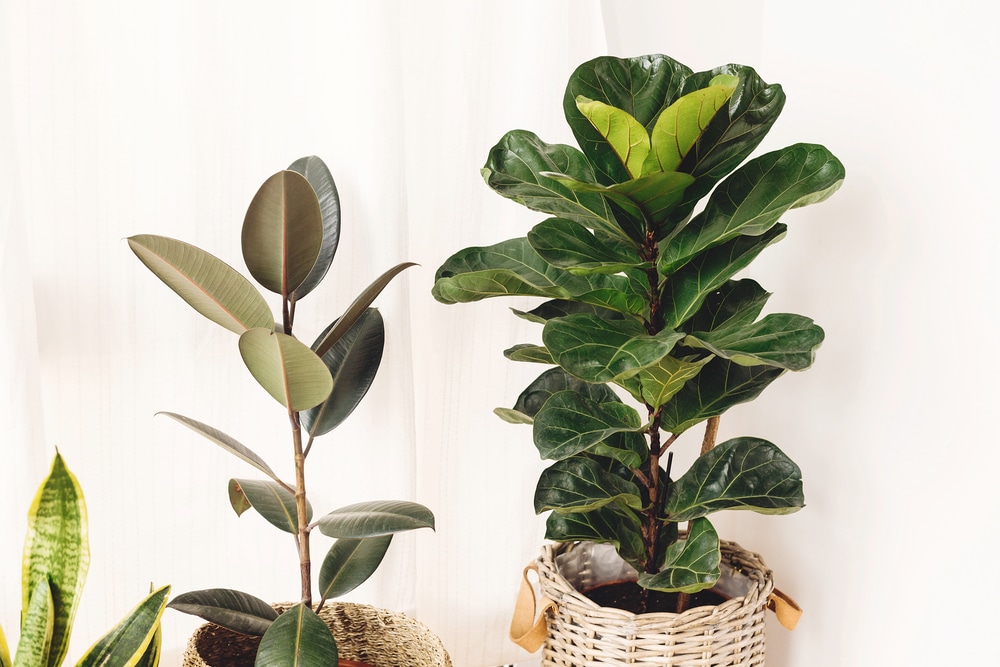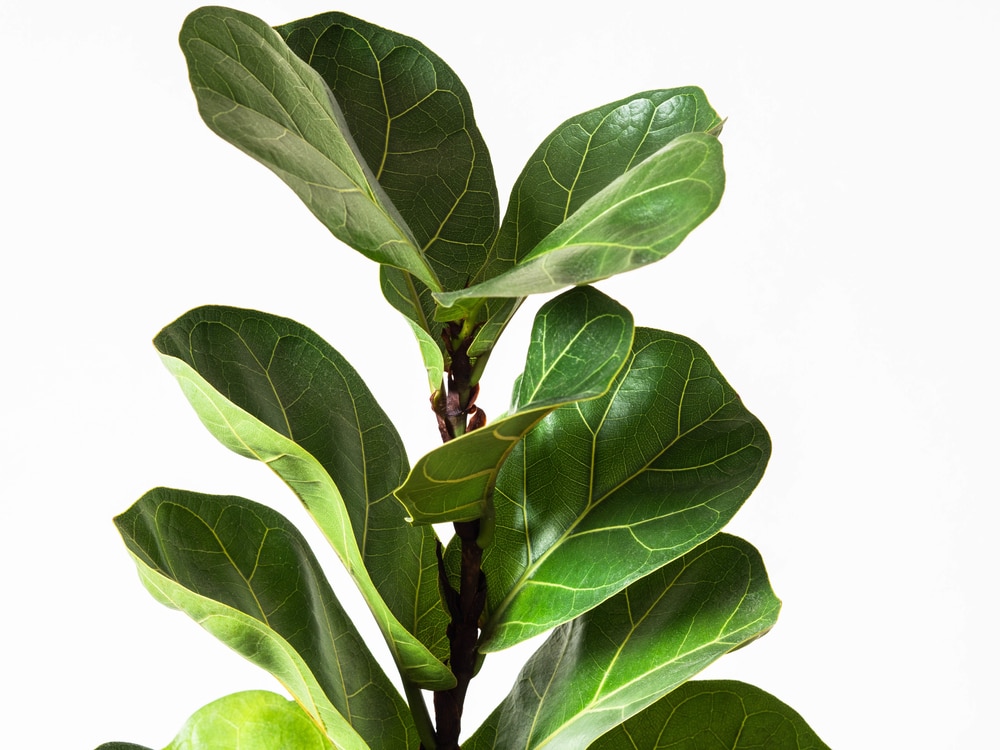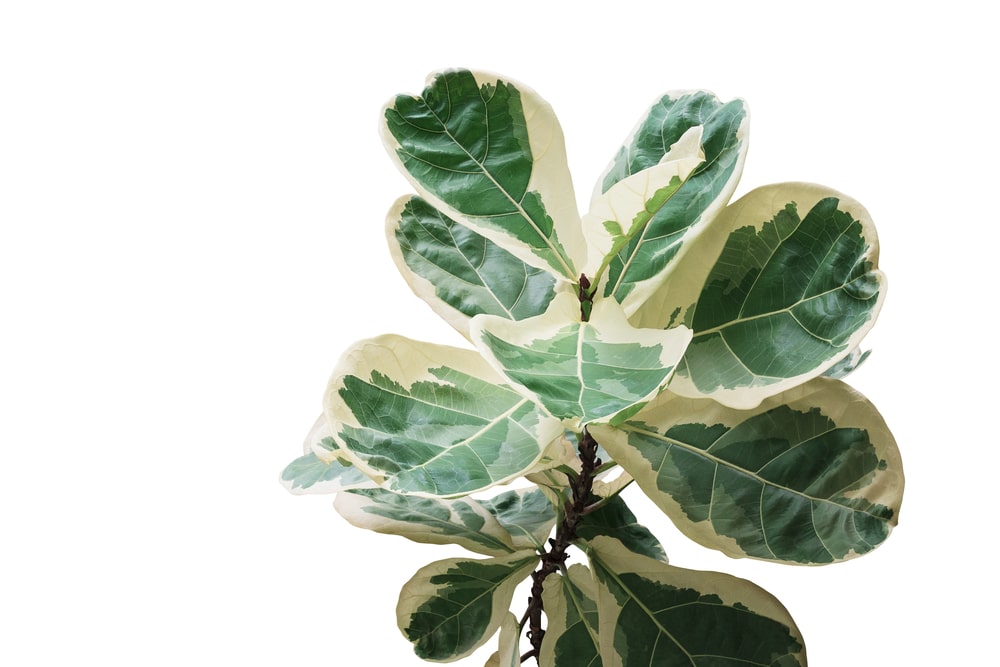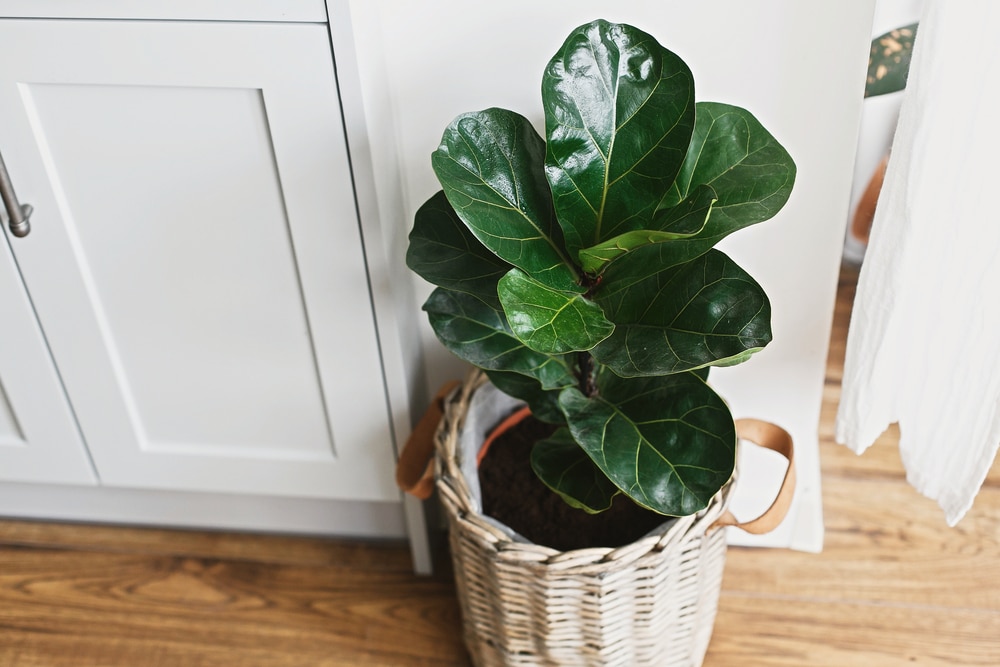If you’ve been in the houseplant world for long, you’ve probably noticed that there are several fiddle leaf fig varieties on the market, and also several pseudo-fiddles that look very similar but aren’t fiddles at all!
Here’s a quick guide to the different varieties of fiddle leaf figs out there and which might be right for you. We’ll also cover some of those similar ficus varieties that might confuse you, or that you may want to add to your collection for a little more variety!
3 Fiddle Leaf Fig Varieties You Should Know About
Here are the three fiddle leaf fig varieties you might find at your local gardening boutique or see online and on social media.
Standard Fiddle Leaf Fig

This is the common, garden-variety (sorry, we couldn’t resist) ficus that you probably think of when you hear “fiddle leaf fig.” This tree typically grows up to 10 feet tall indoors and over 60 feet outdoors, and can be shaped and pruned into the iconic lollipop shape that so many fiddle leaf fig owners covet.
This tree can grow massive, glossy, lyre-shaped leaves that can reach up to a foot and a half long and up to 10 inches across. When fiddle leaf figs are given the proper light, water, and nutrition, they can grow up to 1-2 feet a year!
Most of the fiddles you see in gardening stores are the standard type that will grow up to be a tree. They love indirect sunlight, and when watering, it is best to use a moisture meter to learn when they are ready for a drink.
But sometimes you might think you’re getting a regular baby fiddle when you’re actually holding a dwarf variety.
Bambino/Dwarf Fiddle Leaf Fig

This is a smaller version of the regular fiddle leaf fig that will only grow to be about 5 feet tall, which makes it a great option if you want a fiddle leaf fig but have limited space!
The bambino also produces smaller, more rounded leaves than a standard fiddle. This is the best way to tell the difference between a bambino and a young, regular fiddle. The leaves of a standard fiddle will start out more…well, fiddle-shaped, while bambino leaves might be shaped more like a pear or even an oval. The leaves of a bambino will also typically be smaller than the leaves of a young fiddle.
It can be tricky to tell the two apart when you don’t have one of each to compare side by side, but if you spend enough time looking at standard fiddle leaf figs (Don’t you hang out in garden centers just to stalk plants you might want to buy? No? Just us?), you’ll learn to spot the suspiciously small leaves of bambino fiddle leaf figs.
Variegated Fiddle Leaf Fig

This one’s easy to identify, thanks to its striking dark-green, light-green, and cream or white patterned leaves. However, you definitely won’t find this one in your local gardening store! These trees are currently only grown in one lab in Thailand, though you can sometimes find cuttings from private owners closer to home.
These plants are gorgeous, rare, and expensive. You can easily expect to pay hundreds of dollars for a mature plant or even a cutting. Due to their lack of chlorophyll (the substance that gives leaves their green color and is primarily responsible for photosynthesis), variegated fiddles need more indirect sunlight so they can make energy, but the leaves are also more photosensitive and prone to scorching.
It’s a delicate balance!
If you’re experienced in taking care of fiddle leaf figs and other variegated plants, you might be ready to give a variegated fiddle leaf fig a try. Go for it!
Other Ficus Varieties You’ll Love
Here are some other ficus varieties you might enjoy. Some can be mistaken for fiddle leaf figs, and some look totally different! In fact, these are great trees to add to your indoor plant collection, especially if you have experience taking care of fiddles. Their care is very similar, so if you can handle one, you can easily handle the other and expand your indoor jungle.
Ficus Elastica “Rubber Tree”
Like the fiddle leaf fig, this tree produces fairly large, glossy leaves, but the leaves of Ficus elastica tend to be a much darker green color and are more oblong rather than fiddle-shaped.
Like the fiddle leaf fig, the rubber tree likes lots of bright, indirect sunlight, fast-draining soil that’s evenly moist, and plenty of nutrients.
These trees can easily grow up to 8 feet tall indoors and also come in stunning variegated varieties that boast beautiful leaves with dark-green, light-green, pink, and cream coloring. (A word to the wise: variegated rubber trees are much easier to find and care for than variegated fiddles, so if you have your heart set on a variegated tree but can’t stomach the price tag of a variegated fiddle, a variegated rubber tree might be the answer!)
Ficus Benghalensis “Ficus Audrey”
While very similar to fiddle leaf figs in appearance, Ficus Audrey is known as the fiddle leaf fig’s slightly more laid-back cousin (though they tend to be more expensive and harder to find than the standard fiddle).
The leaves are a bit different as well. While fiddle leaves tend to be large, lyre-shaped, glossy, and smooth, Ficus Audrey leaves are slightly smaller, thicker, lighter in color, and a bit fuzzy!
Like the fiddle, this tree will grow to be 8-10 feet tall indoors.
This charming tree tends to be a bit more flexible with its watering requirements than the standard fiddle leaf fig, but it still likes plenty of bright light. If your home does not have enough light, a grow light can also help to keep your plant healthy.
If you can care for a fiddle, Ficus Audrey will be no problem for you!
Ficus Benjamina “Weeping Fig”
While the leaves of the weeping fig look very different from those on your fiddle leaf fig, this is still a common ficus worth knowing about!
Before the fiddle leaf fig took the stage as the most desired ficus on the market, the weeping fig dominated the indoor tree conversation. These leaves are much smaller and more like a pointed almond shape, and gracefully point downward, giving the tree a relaxed appearance similar to a weeping willow. This tree can grow up to 10 feet tall indoors.
These trees generally prefer the same conditions as a fiddle leaf fig, so if you can care for one, you’re well-equipped to care for the others.
Narrow-Leafed Fig
Ficus longifolia, also known as the longleaf fig, is known for its elongated, downward-pointing, lance-shaped leaves. While it may not be one of those ficuses that you’d confuse with a fiddle, this is great for those who love the look of the weeping fig.
One of the best parts of this tree is that its new leaves begin life with a pink or red color and then gradually turn green!
This tree will only grow up to be anywhere from 5-10 feet indoors. Many houseplant owners like it because it tolerates lower light conditions than many other ficus varieties (though it still prefers bright light).
Ficus Altissima
Ficus altissima, also called the lofty fig or the council tree, has oblong leaves similar to those of the rubber tree, but they’re more pointed and lighter green with more prominent veining. It’s almost like a cross between the rubber tree and Ficus Audrey!
Most of the altissima plants you’ll find (if you CAN find them, they aren’t common) will sport a little lemon-lime variegation. These trees grow up to 8 feet tall indoors and are one of the more easygoing ficuses.
Ficus Bonsai
Ficus trees are actually some of the most popular bonsai trees! While most ficuses are suitable for bonsai, the most commonly used trees are Ficus microcarpa and Ficus retusa. Ficus trees are excellent options for bonsai beginners, as they tend to be pretty hardy and respond well to pruning and wire training.
There’s a Ficus Out There for Everyone
As you can see, there are plenty of options when it comes to fiddle leaf figs and ficus trees in general! No matter what your aesthetic, how much space you have, or your experience level in caring for indoor trees, there’s a ficus and probably even a fiddle for you!
To learn more about fiddle leaf fig care, sign up for our free 30-minute Ultimate Fiddle Leaf Fig Care Webinar and check out The Fiddle Leaf Fig Expert Book!

